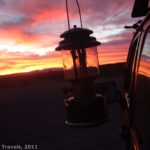
In 2022, I decided to visit the Maze District of Canyonlands in Utah. The Maze is famous for its extreme remoteness, rough dirt roads, and incredibly rugged scenery. The day before I left, I checked the weather in Utah – and found to my horror that it was supposed to be 20F colder than average. In fact, they’d had a snowstorm a few days before I arrived, and it was so cold that the snow wouldn’t melt, even at midday in direct sunlight, and the puddles on the Horse Canyon Road were still frozen solid in the mid-afternoon (yes, I know Horse Canyon is in the Needles District – we stopped there on our way home). Night temperatures dipped into the teens – and I was sleeping in my van, which doesn’t have a heater except when the engine is running.
I learned a lot on that trip about staying warm and generally how to have a wonderful time despite the cold. I’d like to share a few tips below. (Note that this is not an exhaustive list, nor is it meant for snow or tent camping – I’ll be focusing on hiking and sleeping in a vehicle in cold weather. I also will not cover a camper, which might have water pipes, heater, batteries, etc.)
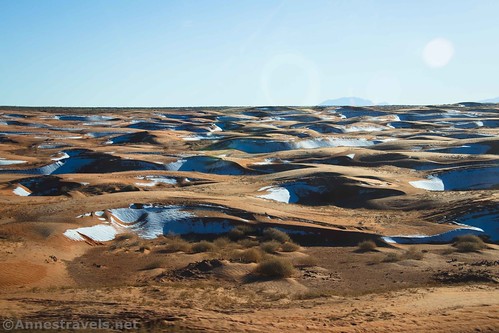
18 Ways to Camp and Hike in Freezing Weather
1. Layers, layers, layers. It’s much better to wear several layers that are easily removable instead of one heavier layer. On that trip, you might find me wearing a t-shirt, long sleeve base layer, exercise jacket (meant for wearing between sporting events), down vest, winter coat, two pairs of leggings, hiking skirt, two pairs of socks (one regular and one hiking with pantyhose in between to prevent blisters), ear muffs, beanie-style winter hat, and one or two pairs of lightweight gloves. I could easily remove any of these layers depending on the current temperature or my current activity.
2. Don’t let yourself get sweaty. If at all possible, remove layers so that you don’t get your clothing sweaty (layers make this much easier). Sweaty clothing means wet clothing, and that won’t keep you very warm once the sun goes down or if you stop to rest.

3. If at all possible, don’t get very cold. Put on more layers or increase activity so that you don’t get chilled. It’s much harder to warm back up than it is to stay warm. (Pro tip: Two ways to get warm before bed are to go for a drive (with the heater on – again, don’t get sweaty) or attend an indoor program (shopping works, too).)
4. It gets frigid when the sun goes down. Especially in the desert, sunny days can feel quite warm – I was hiking in my base layer at times, even though there was still snow on the ground. As soon as the sun goes down, the heat of the day vanishes faster than you’d think was possible.
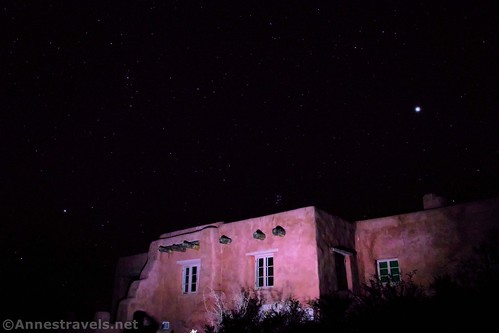
5. Bring extra layers with you while hiking and exploring. In weather below freezing, you want to be extra prepared if something were to happen and you have to self-rescue or shelter in place. It’s also wise to have enough layers to not freeze when the sun goes down (see Number 4). Bring along a headlamp – it gets dark so early and so quickly in the winter!
6. Cover your feet, hands, and head whenever possible. They say most of your body heat escapes through your head, so a hat is imperative. Your feet and hands are most prone to frostbite, so it only makes sense to keep them warm, too.

7. Know your weak points when it comes to cold, and keep those areas warm. For various group members, it’s their neck, feet, upper arms, shoulders, ears… you get the idea. If that body part is cold, it doesn’t matter about the rest of them; they feel cold. Make sure to have plenty of cover for these areas (for example, a scarf for the neck, ear muffs for the ears, a shawl for the shoulders, etc.).
8. Use a winter sleeping bag. Mine is rated down to about 32F, which means it’s really about 10 degrees higher than that. While they do make warmer sleeping bags (down to 0F is somewhat common), I like this one because it’s more versatile across seasons.

9. Bring extra blankets as well as your sleeping bag. Pull one or more of the blankets into the sleeping bag for extra warmth, or use them over your head or around your shoulders. I hate drafts down my sleeping bag with a passion, so I keep a blanket handy to stuff up the cracks around the top of my bag whenever I feel a draft.
10. Put a blanket along the zipper of your sleeping bag. Maybe it’s just my zipper, but I find that the cold seeps in through the metal (or maybe just through the teeth). A blanket inside my sleeping bag, wadded up against the zipper, keeps me much warmer.
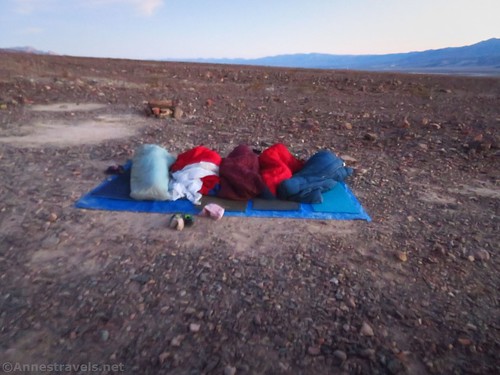
11. Keep blankets handy for day use, too. A purple throw from Walmart has become “my all singing and dancing blanket” – besides stopping up the drafts in my sleeping bag, it’s also great as a lap warmer while we’re driving, a shawl around my head and shoulders, and even keeping my water bottle cold in the summer (not the topic of this post, but it’s all good, too!)
12. Put your legs through the armholes of your winter jacket at night. I don’t completely understand it, but this is a huge reason I can stay warm on cold nights. I have the down vest and multiple layers of lighter jackets/blankets on my upper body.

13. Wear dry clothes to bed – especially socks. I usually don’t bother changing out of my day clothes, but you find that you’re cold, a dedicated, dry set of clothing for sleeping will help a lot. A pair of heavy wool socks (also dry and only for sleeping) is perfect for keeping my feet toasty all night long.
14. Leave the windows cracked open overnight if you’re sleeping in your vehicle. I know this seems like an oxymoron, but the cold seeps in anyway, and the airflow can cut down on the frozen condensation on the inside of the car/van windows. (Or maybe I’m the only one who has trouble with this since there are up to 10 of us sleeping in the van…)

15. Bring an ice scraper. They’re small, usually inexpensive, and they’re much better at getting your windows frost-free than the lid of a cookie container (don’t ask how I know that).
16. Don’t put anything you don’t want to freeze in the windshield. My poor bananas…
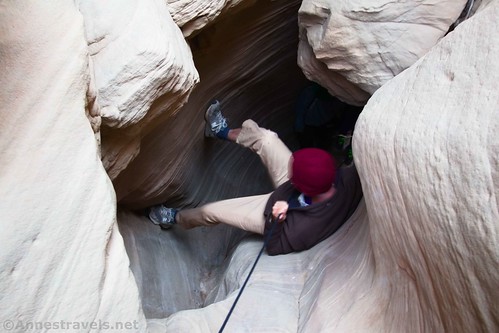
17. If you use a Nalgene or similar hard-sided water bottle, take it into the sleeping bag with you. That way, you can start out the day without drinking a slushie. (Though you might want to make sure the lid is on tight.)
18. You may find that your electronics need to stay warm. I was very surprised to find that my big camera’s aperture stopped working about 32F. Of course, I didn’t figure out the issue until we were home, so I didn’t think to do things like carry the camera inside my jacket.

19. Put jugs of water (with about an inch of head space) outside at night, then move them to the cooler during the day. You won’t have to buy cooler ice all trip long!
20. Enjoy the stars! Cold weather tends to take water out of the atmosphere, making the sky less hazy and the stars more brilliant. There’s honestly nothing quite like watching your breath condense in the air in the light of a battery lantern while waiting for your supper to cook on the camp stove with a glorious star display overhead!
Let me know your favorite tips & tricks for cold-weather hiking in the comments!
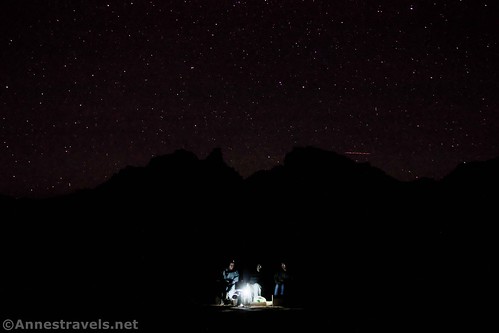
Today’s Featured Product
This is called a “helmet liner,” and it’s specifically for biking. But I love its ability to keep my ears warm on hikes and all kinds of outdoor activities. Buy yours here.


